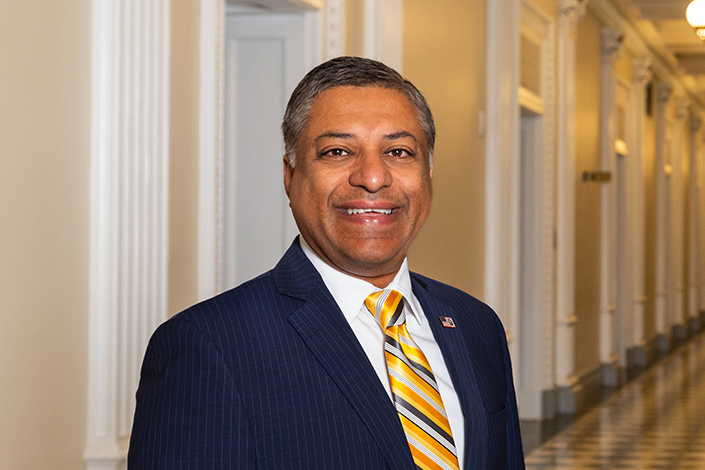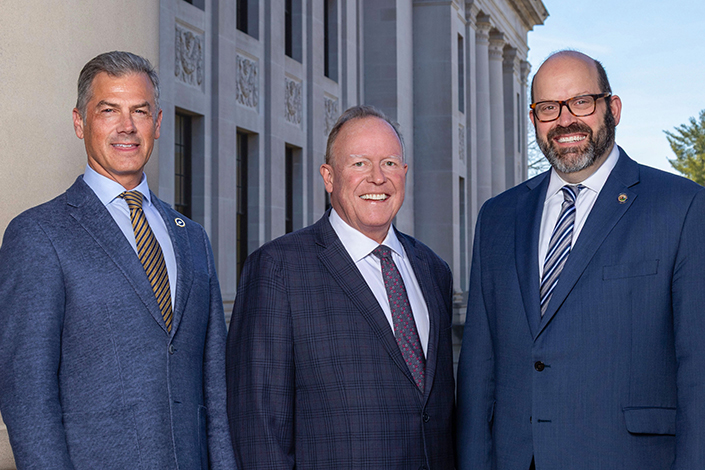A Q&A with Dr. Rahul Gupta
By Megan Bevins

Dr. Rahul Gupta, director of the White House Office of National Drug Control Policy (ONDCP), has spent his career in medicine, public health and diplomacy, addressing some of the most pressing challenges facing communities today.
From his early days as a physician in rural Alabama to his leadership roles in West Virginia and Washington, D.C., Gupta has witnessed firsthand the devastating impact of substance use disorder. Inspired by what he witnessed, he has worked to combat the opioid epidemic, improve access to treatment and disrupt global drug trafficking networks, saving countless lives along the way.
WVE:
Can you share some key experiences from your life in India and Washington, D.C., and early career that shaped your perspective on substance use treatment and public health issues?
RG:
Growing up in India and the U.S. gave me the unique opportunity to understand and appreciate both the more collectivist approach of the East, where there is a strong emphasis on tradition and family ties, and the more individualistic approach of the West, where we are proud of our personal expression and individual freedoms.
When I was young, I lived in the northern state of Jammu and Kashmir in India. I remember seeing people under the influence of alcohol passed out in the street. Growing up in Maryland, street dealers would offer me drugs on the way home from school, and I didn’t know how to react.
As a physician, I’ve seen the effects of substance use disorder up close. I have treated and resuscitated hundreds, if not thousands, of people with drug overdoses, many dying in my arms in the process. Similarly, I’ve had the opportunity to treat patients with several public health conditions, many of which physicians often do not commonly encounter in the U.S such as leprosy, plague, dengue fever, trachoma and cholera.
WVE:
What inspired you to pursue a career in medicine and public health after earning your degrees?
RG:
Today, residency programs generally focus on disease categories and rotations. They often lack training in health systems, basic public health and policy. Yet, practicing physicians frequently spend their professional career battling with insurers, policymakers and various hospitals and health systems in order to advocate for patients. In my first job in rural Alabama, I saw up close how the health care system was failing my patients. Several times a week, I witnessed elderly patients have to decide between paying for food or medication. I wanted to help change the system on a larger scale, which is why I enrolled in a Master of Public Health program at the University of Alabama-Birmingham. When the opportunity presented itself, our family moved to Charleston, WV, to accomplish that goal. As health officer for the Kanawha-Charleston Health Department, I was thrilled to pursue the dream of helping people at a population level. I started off leading county health departments and then moved on to the state health department.
WVE:
How has being raised as the son of a diplomat influenced your life choices and work?
RG:
At the White House, I work at the intersection of national security, public health, financial security and international diplomacy. Every prior experience has helped prepare me for this role, and this includes seeing diplomacy up close as the son of an Indian diplomat. One of my greatest responsibilities is working with other countries to disrupt the flow of deadly drugs into the U.S., including Mexico, India and the People’s Republic of China. Our country’s relationship with China is a difficult one, and sometimes the only area in which we’re making progress with them is drug policy because both countries recognize this is a shared problem. With India, I was there just last October to build on our two countries’ agreement to the most significant drug policy framework in history. This far-reaching and innovative bilateral agreement addresses not only counternarcotics and global public health but also the pharmaceutical supply chain, which drug traffickers are trying to exploit. When it comes to the global synthetic drug crisis, I joined Secretary of State Antony Blinken to announce the launch of the Global Coalition to Address Synthetic Drug Threats, which has brought together more than 150 countries.
WVE:
What motivated you to focus your work on substance use? Specifically, what led you to West Virginia?
RG:
I came to West Virginia to lead the Kanawha-Charleston Health Department, the largest in the state, and took on leading the Putnam County Health Department at the same time.
When I became the state health commissioner in 2015, I was tasked with managing health problems facing the entire state. Substance use disorder was at the top of that list, and I was determined to stop our people from dying.
In 2016, I ordered a social autopsy of the state’s overdose deaths, which was the first of its kind in the nation. We found that the people who were dying often didn’t finish high school and had blue collar jobs. They had interacted with the health system a number of times, including after overdoses, but the health system didn’t help get them into addiction treatment. So, we took several steps to change the status quo. We worked with the Legislature to create the first office of drug policy in West Virginia’s history so someone would be overseeing our state’s response.
WVE:
Reflecting on your years in West Virginia, what strategies have you seen effectively combat substance use issues in rural areas, and what role do local communities play?
RG:
West Virginia is a resilient state full of wonderful people—some of our nation’s best and brightest—but it’s often overlooked and under-resourced on the national stage. I brought this knowledge and experience with me to the White House, and it’s helped me channel our efforts into saving lives across rural America.
At the same time, some of the most important work to address this crisis happens at the local level. It’s critical that people in local communities have the tools they need to succeed. This includes knowing the risks of fentanyl, the lifesaving power of naloxone and how to get it and where to turn for treatment and recovery support services. When I was in West Virginia, I signed a standing order so people who needed naloxone could get it without a prescription. Thanks to our work in the White House, naloxone is now available over the counter and more accessible and affordable than ever before. Similarly, there are 15 times more medical providers today who can start people on treatment for opioid addiction than any time prior. We’ve also empowered local communities to take action by providing policy direction, tools and funding to help people in the community.
WVE:
Can you discuss a significant challenge you’ve faced in your work and how you overcame it?
RG:
The biggest challenge I faced was being asked by the President of the United States to bring down the number of people dying from overdoses and help turn the ship around so we can beat the opioid crisis. When President Joe Biden came into office, our country was facing overdose death rates of 31% a year. Drug traffickers and producers were moving at the speed of business, and we were moving at the speed of government. As the first practicing physician to hold this office, it was up to me to come up with a clear plan to save lives. We put a goal into place to cut overdose deaths by 13% by the end of 2025, and we created evidence-based policies to get there.
Last December, we announced a 17% drop in overdose deaths—that’s a 48% turnaround. Not only did we surpass our goal, but we did it a year and a half ahead of schedule. Below are three important steps that led to this unprecedented drop, which has saved over 500,000 Americans.
As any EMT, soldier or trauma doctor will tell you, the first thing you need to do is stop the bleeding. If you don’t, nothing else matters. We knew one of the quickest ways to save lives was to get more naloxone or Narcan into people’s hands, and we surged funding to states to buy it.
We also launched the White House Challenge to Save Lives from Overdose, which has brought together major companies like United Airlines and Major League Baseball as well as small businesses in towns across America to commit to having naloxone on hand so they can save a life.
We needed to make treatment more accessible and available than obtaining drugs. It used to be that a doctor could prescribe opioids but needed an extra license called the x-waiver by the DEA to be able to treat patients with opioid addiction. We removed that barrier, and by eliminating the x-waiver, increased the number of prescribers 15-fold.
For too many years, drug traffickers have counted their money while we have counted our dead, and we need to turn that around. This is a global business, and we need to treat it like one. Taking out kingpins and cartel leaders is necessary, but it’s not sufficient.
We have made drug production more costly, difficult and time consuming. Detecting all the drugs we can and seizing what we detect is not enough. We needed to go deep into the production and supply chain and stop the drugs from being made in the first place.
At the same time, we are continuing to seize record amounts of fentanyl at the border—before it can kill Americans—and go after the supply of drugs in new ways. We’re going after the finances and illegal profits of drug traffickers; holding more people accountable, including the lawyers, accountants, brokers and real estate agents who enable drug trafficking and money laundering; and under the president’s executive order, we have sanctioned more than 300 individuals and entities involved in drug production and trafficking, cutting them off from the U.S. financial system, including cartel leaders, their enablers and facilitators and chemical companies, especially in China.
WVE:
What motivated you to focus on the opioid epidemic during your tenure as director of the West Virginia Bureau for Public Health?
RG:
It was clear to me we had among the highest rates of overdose deaths in the nation, and we also had several challenges related to it. This included building the workforce we needed to address our economy, finding placements for foster kids and addressing our aging population, as well as the limited opportunities for young people in terms of health and economic opportunity. I worked with the governor, Legislature and other leaders from the education, business and the faith communities and so many others to help move us all in the right direction.
WVE:
As the director of the Office of National Drug Control Policy, how are you advocating to address the overdose death rate in West Virginia?
RG:
The work outlined in the 2022 and 2024 National Drug Control Strategies has defined and directed our nation’s path forward in beating the drug crisis as well as the historic levels of funding that have come from the federal government. West Virginia has utilized this funding to expand naloxone distribution, improve access to treatment—including telehealth and virtual treatment—and harness the power of recovery for Mountaineers. At the same time, we also have incredible law enforcement officers working together through the ONDCP’s grant program and the High Intensity Drug Trafficking Areas (HIDTA) Program. With support from ONDCP, the Appalachia HIDTA is working at the federal, state, tribal and local levels to stop drug traffickers and keep as many drugs out of our state as possible. Additionally, preventing youth substance use before it even starts is critical, and many schools across West Virginia are engaged in prevention programs. Finally, the state is leading in recovery programs. I recently visited the state and saw 14 businesses had signed up to become recovery-ready businesses, which means helping people in recovery stay in recovery through employment and having a chance to be a part of the community.
WVE:
Can you discuss the importance of funding addiction treatment programs for incarcerated individuals?
RG:
On any given day, there are around 2 million Americans incarcerated, and two-thirds have a substance use disorder. People reentering society die at unprecedented rates from a drug overdose, especially in the immediate days and weeks after they’re released. Others are often re-incarcerated with society paying the costs.
We had a significant opportunity to not only save lives but also improve the ability for individuals to be successful after leaving incarceration, find employment and stay out of jail.
We made it easier for states to use Medicaid funding to treat people for addiction before leaving incarceration, which is going to save thousands of lives.
WVE:
As the inauguration of a new president approaches in January, what are the plans for transitioning your position to the next director?
RG:
Smooth transitions from one presidency to the next are a core part of our democracy. ONDCP’s lifesaving work must continue regardless of the administration change. Therefore, I am committed to a world-class transition to the new administration. ONDCP is filled with incredible experts and professionals, and they are ready to quickly and effectively support the next group of leaders.








